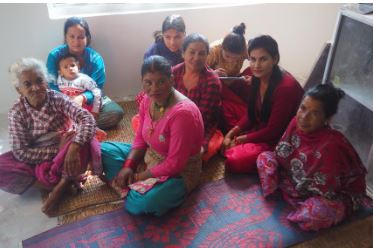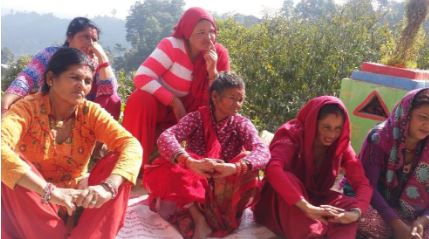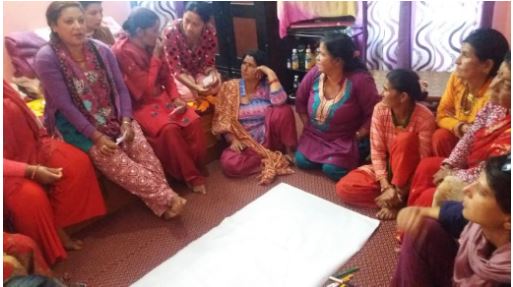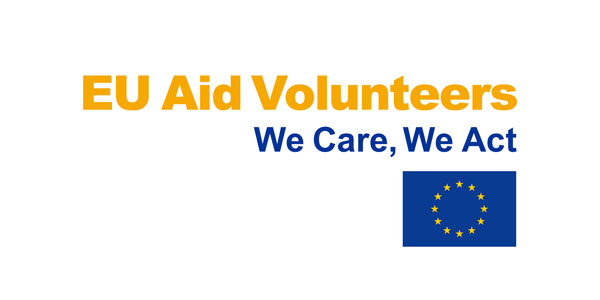Location: Khartithok (Kavresthali) & Tinpiple (Jitpurfedi)
Dates: 12 November (Khartithok) & 13 November 2018 (Tinpiple)
Pilot one-session workshop delivered by Patricia Iacob and Chiara Caminiti (EU Aid Volunteers on gender issues) with the help of Razni Karki (local volunteer).
That domestic violence is part and parcel of rural women’s daily lives in Nepal should not take anyone by surprise by now. It is well-known that poverty and lack of education throw women into marriages from early ages, robbing them of a well-deserved childhood. Plunged into lives of servitude, defined by household chores and difficult, back-breaking field work, they are deprived of opportunities to educate themselves, to gain life skills and practical knowledge allowing them to participate as active members of their respective communities.
Volunteers’ Initiative Nepal, a not-for-profit organisation active in the impoverished communities of Kavresthali and Jitpur Phedi, has put in place, under its Women Empowerment component, an Education, Rights and Life Skills programme aimed at making women independent, responsible actors in their own lives and in that of the communities they inhabit. A series of trainings and practical workshops has been organised to bring about the desired change.
With the arrival of the two long-term EU Aid volunteers (Patricia Iacob and Chiara Caminiti), who have already been working for two months in these impoverished communities, their female residents have now a new chance of opening up and gaining self-confidence. Based on the surge of cases of domestic violence which, more often than not, go unreported and thus unpunished due to cultural constraints, the volunteers embarked on an awareness-raising pilot project focusing on gender rights, domestic violence and life-improvement skills.
The first workshop of the series focused on domestic violence and was designed as an interactive encounter, where women could feel at ease, safe, and ready to take in all the information on such a sensitive subject. To enhance the women’s comfort, the workshop was carried out in Nepali language with the precious help of Razni Karki, a local volunteer. The focus communities were Khartithok (Kavresthali) and Tinpiple (Jitpur Phedi), where the workshop was organised on two consecutive days, 12 and 13 November 2018, attended by a total number of ten and eleven participants, respectively.
Method and structure. 1. Warm up session (presentation of each participant with the introduction of the theme of the meeting, while standing up and holding hands in a circle to increase the women’s sense of security and comfort); 2. Brainstorming session – what is domestic violence for you? We asked women to come up with ideas, freely, which we wrote on individual post it notes;
- The intensity of violence scale – how would you rate these instances of domestic violence by their intensity, from low to high? We drew a straight line on a white cardboard on which we placed the post-it notes according to the women’s understanding;
- Video on the definition of domestic violence (13-minute video in Nepali language);
- Types of domestic violence (physical, emotional, social, economic, and sexual) – where would you place the instances of domestic violence you identified yourselves? On a different cardboard, we divided a circle into the five corresponding sections and placed the same post-it notes as the women thought suitable;
- Nepali law on domestic violence and available remedies – a short informative video followed by practical advice with responsible authorities and useful numbers to contact (written on a cardboard paper pinned to the wall);
- Visualisation exercise/body outline – we asked one woman to lie down on white papers and let her body outline be drawn in coloured felt-tip pens by the other attendants. Once this was done, we asked them to place the post-it notes on those body parts they identified with the respective forms of domestic violence.
- Strengthening self-consciousness and female identity – the women were asked to find a remedy for each type of domestic violence they identified; once a remedy was found, the post-it note was crumbled and thrown into a bowl. When the body outline was again clean of violence, the women were given free hand at assigning it an identity by drawing its features, clothes, and jewellery how they saw fit.
- Purification – appealing to elements of Nepali culture, we ended the session with a purification ritual. We invited the women to place marigold flowers on each other’s heads and then sprinkle petals on the female body outline, putting their best intentions and seeing it as a whole being, free from pain and violence. The final step was the symbolic act of burning the crumbled post-it notes.
- Ending circle – we ended with the same circle from the beginning, in which the women were encouraged to share their experience of the workshop and the knowledge they had acquired.

Dynamics and findings. The two workshops have provided interesting insights on local group dynamics as well as valuable information on the level of knowledge and awareness of rural women on the sensitive issue of domestic violence. For example, the introduction circle was impossible to realise at the workshop in Tinpiple village due to cultural practices related to female menstruation (several women refused to touch one of the attendants who was menstruating at the time of the workshop; to her misfortune, she was isolated from the group and attended the session in silence, without a chance to express herself despite our best efforts to involve her).
As far as awareness and knowledge on the issue go, the women from both communities identified the following issues as domestic violence: beatings, vulgar words, mental abuse, alcoholic husbands, lack of decision-making power, lack of property, sex-based abortion (disfavouring female foetuses), polygamy, work discrimination (not having housework recognised as actual work), discriminatory religious practices (such as the prohibition of a woman to put fire to the dead body during cremation), rape, early marriages, dowry system, age discrimination in the family (old women are mistreated or ignored), violence between in-laws, treating widows as witches, and general discrimination between boys and girls within the family.
When asked for possible remedies to these problems, the women became extremely vocal, shared sensitive personal experiences and advanced ideas such as: the need for adequate education, knowledge of women’s rights, prohibition of gender checks before birth, the need to speak up when violence occurs and report it to the authorities, teaching children from early age, as well as the need to emphasise gender equality within the family. While this level of awareness can be considered as positive, most views are of a general nature and thus difficult to see how they could be implemented in practice. On the other hand, we also heard views which pertain to deeply ingrained beliefs rooted in centuries of cultural practices. For example, the women talked about the need to see castes as equal instead of viewing the caste system as the problem itself; or they supported the idea that a widow should not be considered a witch but instead be seen as possibly suffering from mental issues in need of treatment.
Notwithstanding the concern such issues may rise in the present context, the overall environment and dynamics registered at both workshops lend a positive note to the whole project. Women are still trapped in archaic cultural beliefs but slowly open up to new views and ideas. The enthusiasm they expressed at the end of both sessions and the request for a follow-up testify to the potential lying with the female component of these rural, disenfranchised communities and gives sense to our shared endeavours.


Author: Patricia Iacob


